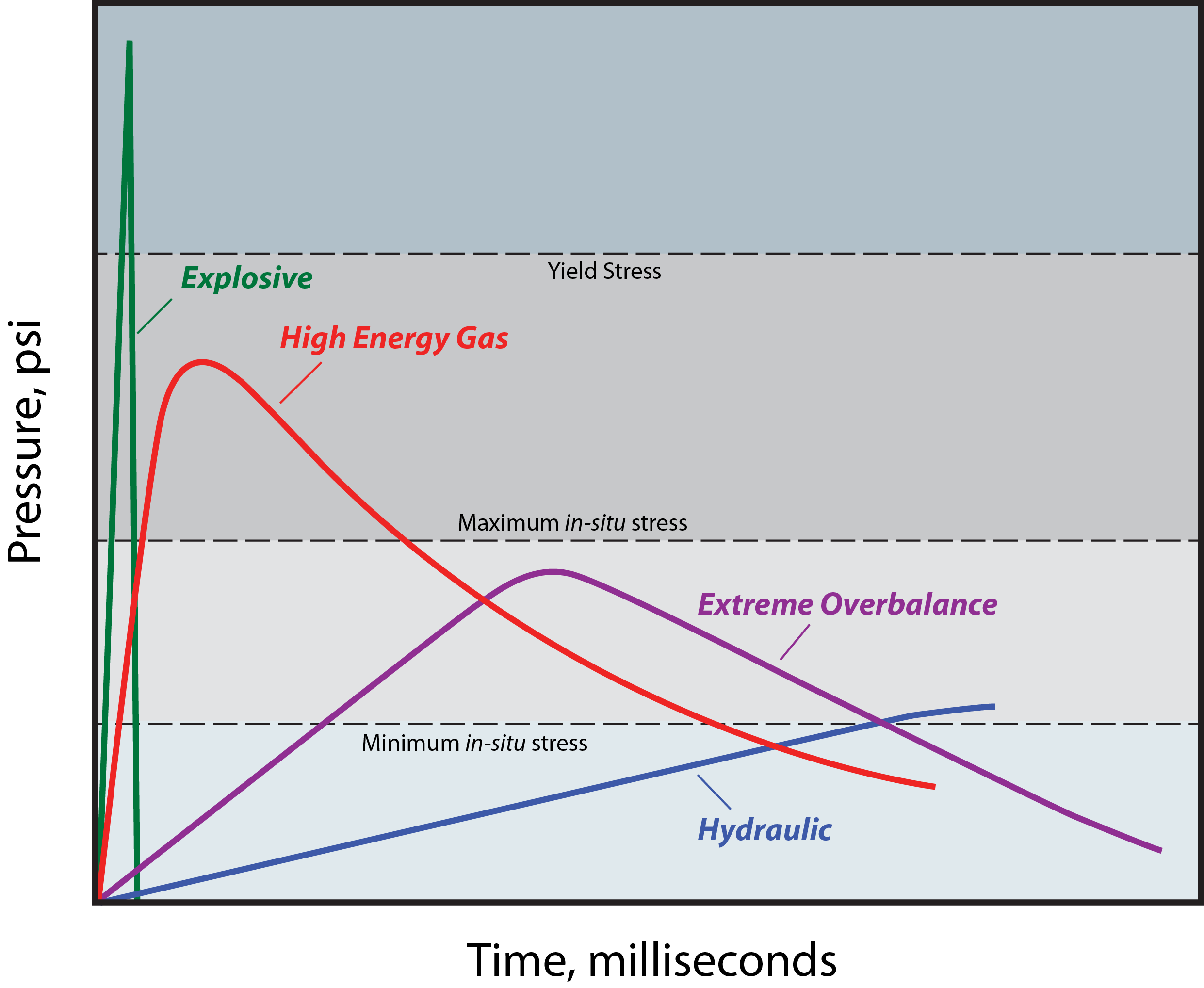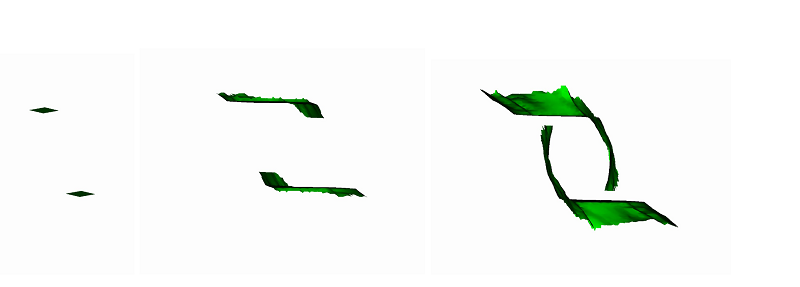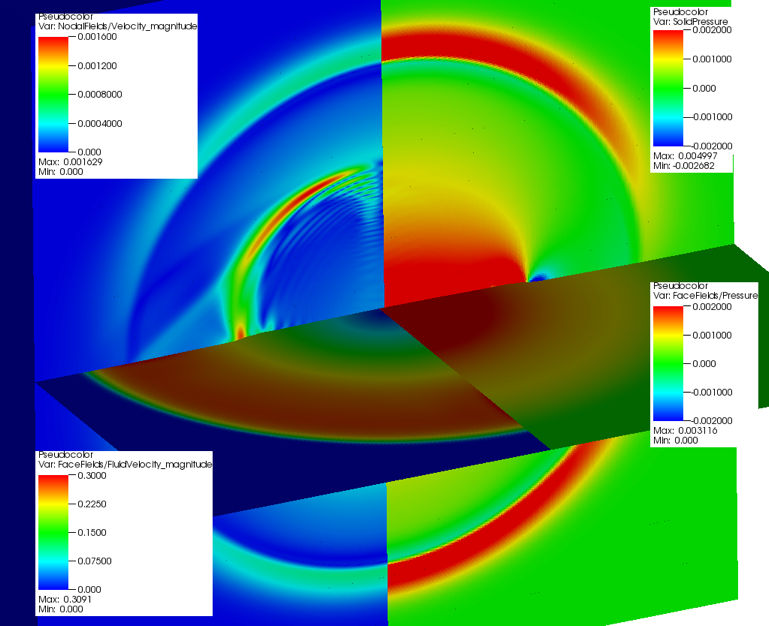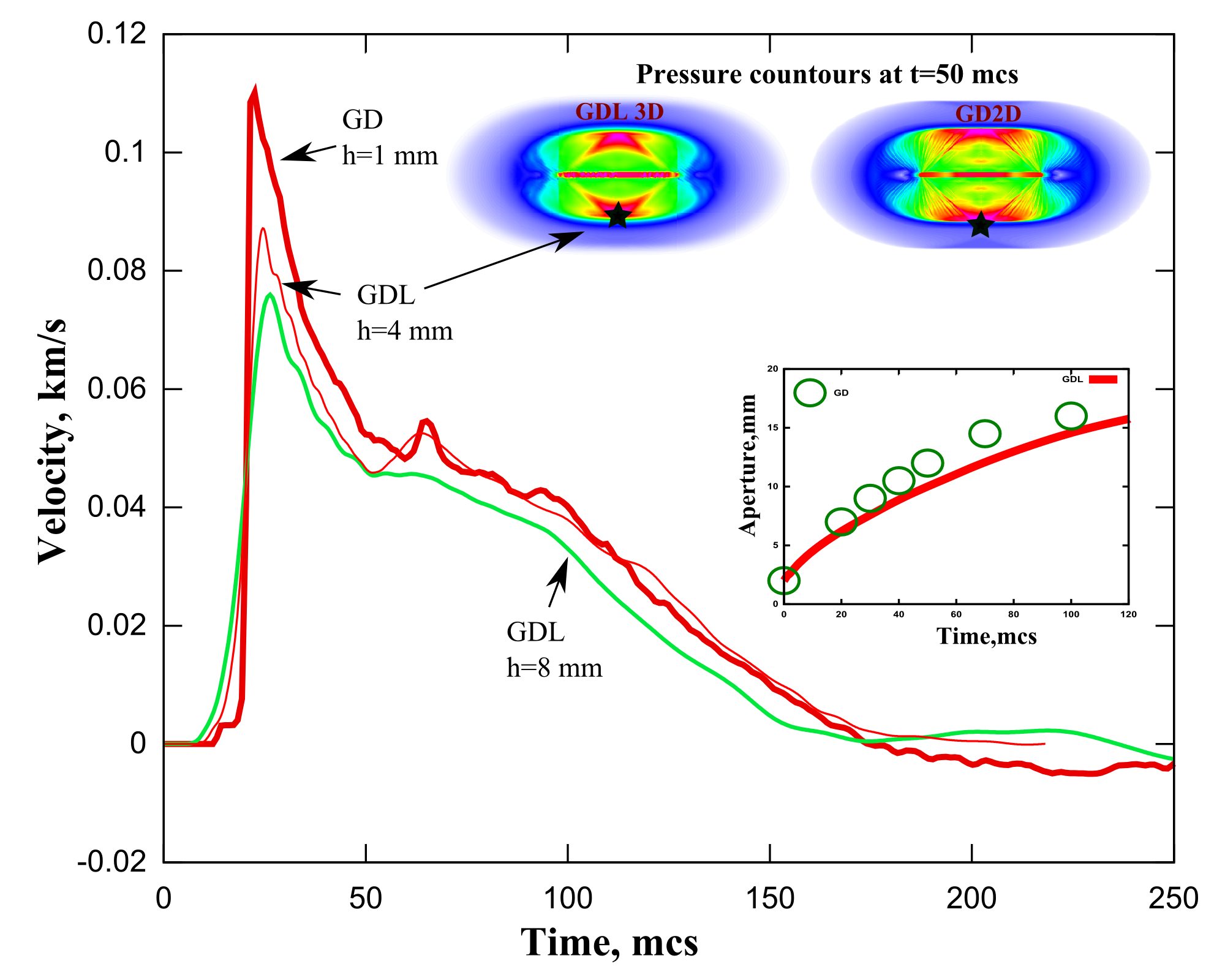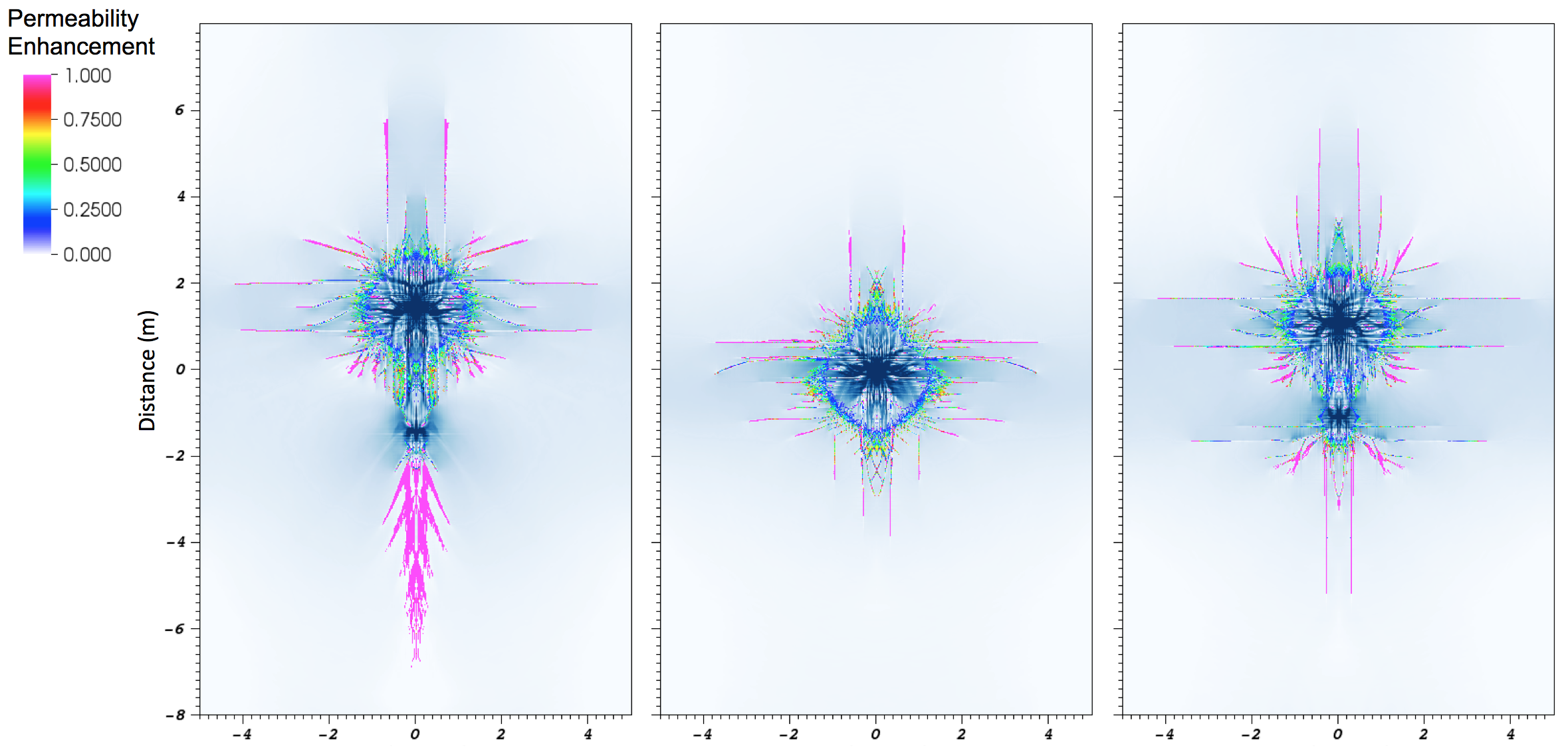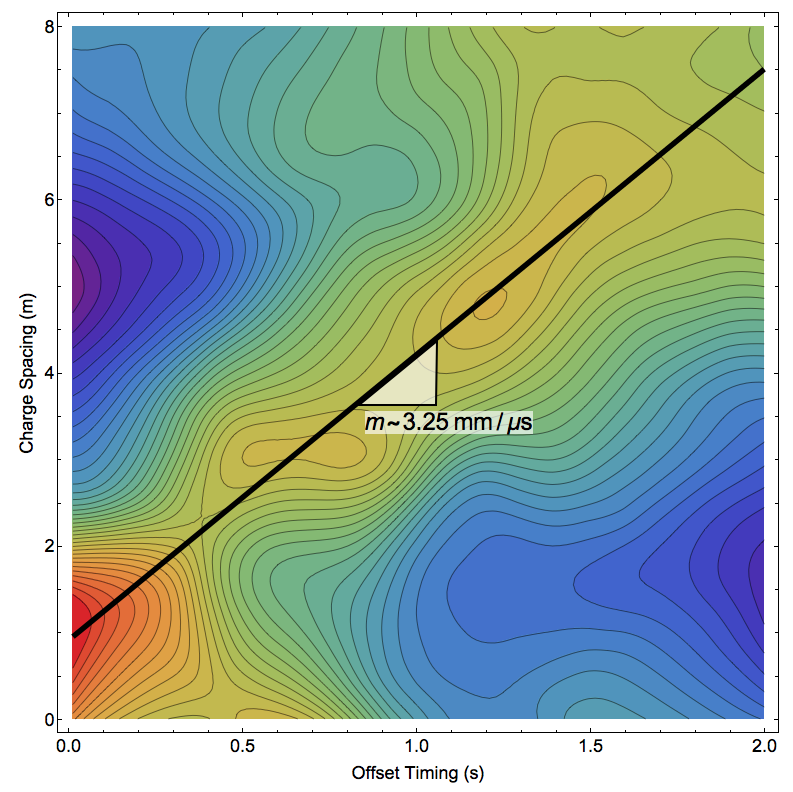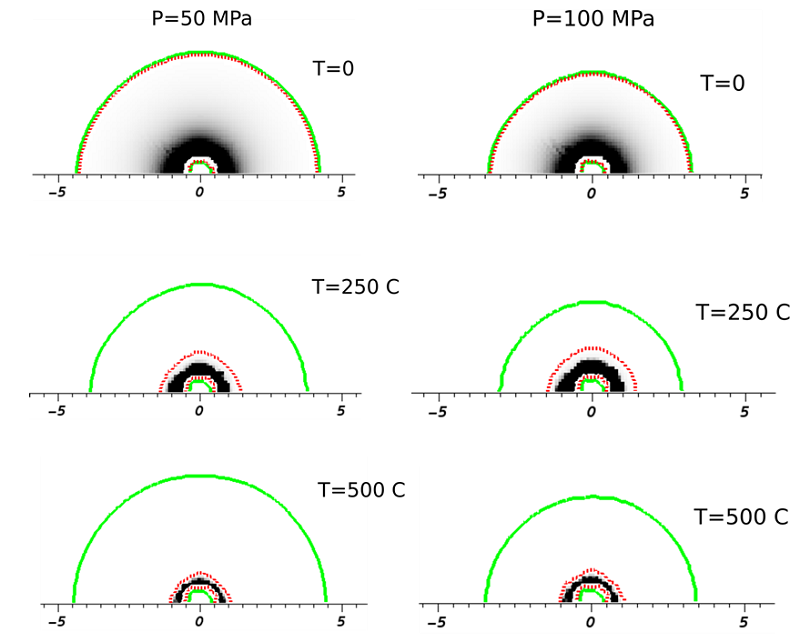Joseph P. Morris (15-ERD-010)
Abstract
Massive hydraulic fracturing has unlocked previously untapped unconventional oil and gas reserves. Wells stimulated by such means are believed to leave the vast majority of the oil and gas untouched. Consequently, there is a desire both to reduce water usage and explore dynamic stimulation techniques that might leave less resource in place. This project addressed this challenge on two fronts. One focused on the implementation of advanced fracture capabilities for investigating the effects of dynamic stimulation. The second focused on the application of the current capabilities as part of extensive parameter studies. On the model enhancement of GEOS fracture-simulation software (developed at Lawrence Livermore National Laboratory), we developed an algorithm to dynamically enrich the background mesh to account for fractures within an extended finite element method (XFEM) framework and implemented XFEM capabilities in GEOS in two-dimensions (2D) and three-dimensions (3D). We benchmarked this new capability against existing cohesive-element-based approaches and results from the literature. A new GEODYN-L software treatment for explosive-filled cracks was developed that enabled elaborate energetic scenarios to be considered more efficiently. We implemented a subgrid-scale model that avoids 3D meshing of the explosive and yet reproduces results obtained at high resolution. Finally, we implemented a Godunov scheme (used for solving differential equations) within GEOS to enable compressible- and shock-physics modeling with full geomechanical coupling.
Our extensive parametric studies lead to the following general conclusions regarding the performance of high explosives in the stimulation of geological resources.
- Explosives can overwhelm stress and create more uniform isotropic fracturing than hydraulic stimulation.
- In the absence of natural fractures or bedding, enhancement extends approximately 10-30 times beyond the charge radius; and stress at depth can reduce the range of stimulation by 15 percent.
- Pre-existing discontinuities further increase the range of stimulation by another two times, out to roughly 100 times the initial charge radius.
- Multiple charges can have synergistic effects, but timing the charges is critical.
Background and Research Objectives
In traditional hydraulic-fracturing stimulation, the effective conductivity of low-permeability rock is increased by generating or activating fractures through injection of pressurized fluid (Eaton, 1969; Simonson et al. 1978). Developments in horizontal drilling combined with massive hydraulic fracturing operations have resulted in a boom in United States gas and oil production. Increases in hydrocarbon extraction from unconventional resources have primarily come from shale-gas and shale-oil resources, where hydraulic fracturing is used to increase formation permeability and enable production. Despite technological successes, the vast majority of shale formations, even within the continental United States, remain untapped due to an inability to effectively produce fracture networks in these types of shale. Moreover, even in producing formations, the recoverable amount of hydrocarbon is only a small percentage (as low as five percent) of that available within the reservoir; most of the oil and gas is left in the ground. New technologies are required to increase extraction efficiencies and ensure the long-term sustainability of shale-gas and shale-oil production.
One possible extension of traditional hydraulic fracturing is to increase the loading rate of the driving fluid. Methods that use dynamic loading potentially extend stimulation to previously unrealized geological resources (Reeves and Weida, 1995). With an increasing rate of injection, such as that achievable with explosives or propellants, it is possible to create fractures at arbitrary orientations (see Figure 1) and potentially stimulate the near well-bore region more uniformly (Reeves and Weida, 1995). Such an approach relies on the ability of stress waves produced by an explosive charge to overcome the in situ stresses and create fractures in various directions, in contrast to one preferentially aligned fracture formed during hydraulic fracturing in uniform rock. Dynamic stimulation may also require less water than is currently used in hydraulic stimulation, thus extending the use of reservoir stimulation to resources in water-stressed regions of the United States and elsewhere, as well as ameliorating potentially damaging environmental effects associated with fracturing fluids and produced water. The objective of this project was to develop a modeling capability for the design of dynamic-stimulation procedures to enhance hydrocarbon resource recovery and to extend the use of such methods to previously unproductive reservoirs.
Figure 1. Characteristic fracture patterns developed as a function of pressure pulse relative to materials properties (Swift and Kusubov, 1981).
Scientific Approach and Accomplishments
GEOS XFEM Development
We developed a local, implicit crack-tracking approach to propagate embedded failure surfaces in three-dimensions (Annavarapu et al. 2016). This approach built on the global algorithm-based crack-tracking strategy of Oliver et al. (2004). We modified the algorithm to improve stability and accuracy. The resultant method exhibits better behavior in the presence of closely interacting fractures and provides a viable strategy to robustly evolve embedded failure surfaces in 3D. Figure 2 shows a demonstration 3D simulation of the interaction of two offset, pressure-driven fractures. In this instance, the influence of a fluid is modeled by a traction boundary condition, appropriate for very slow injection rates. Future work will extend the capability to include true coupled fluid flow.
GEOS Coupled Gas-Driven Fracture Capability Development
We developed a new numerical model for predicting late-time gas-driven fracturing associated with the use of propellants and high explosives. By incorporating high-rate gas-driven effects it is anticipated that the resulting simulator can be used to optimize a spectrum of stimulation activities from hydraulic fracturing, to gas stimulation, to propellants and high-explosive scenarios. A reduced-dimension Eulerian Godunov Finite Volume solver was implemented within the Laboratory's GEOS simulation framework (Settgast et al. 2016). Figure 3 shows results for a block (50 mm x 50 mm x 100 mm, 200 x 200 x 400 elements) of linear elastic material with a pre-existing flat-plane fracture filled with adiabatic ideal gas running through the middle of the plate. A small source region of fluid at the center of the fracture is given an increased specific internal energy of 10 kJ/g, thus generating a source for the propagation of a wave through the fracture. The solid pressure is shown on the right, while the solid velocities are shown on the left. Extruding from the body are the fluid pressures (right) and fluid velocities (left). The plots of pressure show the main compression wave travels radially from the source, followed by a secondary compression wave related to the opening of the fracture.
Figure 3. Plot of deformed body (x200 magnification) colored with solid pressure, solid velocity, fluid pressure, and fluid velocity at t=20s for a 3D problem with an internal energy of 10 kJ/g. The fluid pressure and velocity are shown as extruded planes from the solid body.
GEODYN-L Model for High-Explosive-Filled Cracks
A complementary approach was also implemented within the GEODYN-L software. In GEODYN-L, joints and cracks are treated as embedded discontinuities, which are compliant only in normal directions. Rather than explicitly discretize the crack surfaces, we developed a sub-cell model for the explosive-filled cracks. To verify the new method we benchmarked the GEODYN-L approach against a more expensive, high-resolution GEODYN-E calculation. Figure 4 shows that, with mesh refinement, the GEODYN-L solution approaches the one calculated using GEODYN-E.Figure 4. Comparison of high-resolution 2D Eulerian calculations (GD) with 3D Lagrangian calculations in GEODYN-L (GDL) using the sub-cell fracture model for energy released in a circular crack embedded in rock material. The inset shows velocity evolution at the point one radius away from the disk center and aperture evolution in the middle (line) versus crack opening calculated in GD.
Interactions Between Multiple Explosive Charges
Given a fixed amount of explosive, it is not immediately clear if there is any benefit in separating a single source into a number of smaller sources located at some distance from each other. Spherical shock waves generated at each charge's location can interact and create stress conditions favorable for causing more rock damage than that produced by a single charge. Keeping the total mass of two energetic sources constant, we ran an exhaustive parameter study, varying the spacing, timing, and relative size of the two charges and evaluated the permeability enhancement for each scenario. We observed varying amounts of stimulated volume around each charge and the interspatial region between charges, depending on charge radii, spacing, and timing between source initiations. The amount of damage immediately surrounding each source was dependent largely on its size/energy output. Although the total energy released from the sources was constant, the total volume stimulated and the geometry of the stimulated volume was found to vary across our parameter studies due to both constructive and destructive interference among the waves emanating from the detonations. For example, Figure 5 compares the permeability enhancement for just three of the scenarios considered. We observed that the performance was very sensitive to the timing of the detonations.
However, other general trends were also observed. For example, Figure 6 shows a slice through the parameter space that demonstrates that the greatest enhancement is achieved when the second charge is detonated as the shock-wave from the first charge arrives.
Figure 6. Results of a two-charge study for a slice through the parameter space corresponding to equi-mass charges.
The Influence of Pre-Existing Fractures
Pre-existing fractures can experience shear-enhanced dilation that would be expected to improve the permeability of the formation. Figure 7 compares results obtained with and without fractures, and with and without fluid in the fractures. In the absence of fractures, we observed a slight decrease in the extent of stimulation with increasing stress, and the stimulated region had a radius of less than approximately 1 m. With dry cracks and no confining stress, we observe stimulation out to approximately 2-3 m radius and see reductions in the stimulated region as the confining stress is increased. The scenarios with saturated (“wet”) fractures exhibit slightly more extensive stimulation and reduced stress dependence.
The Influence of High Temperature
Energetic stimulation has been considered for the enhancement of geothermal resources. Geothermal applications, by definition, involve rock at relatively high temperature. We developed a model that will allow us to predict when rock failure will lead to improved permeability at elevated temperatures (Morris et al. 2017). With increasing depth, we expect multiple factors will reduce the degree of brittle fracturing. First, with increasing temperature at depth, the yield strength of the rock is reduced. Second, with increasing confining stress at depth, the stress path followed during dynamic compression of the rock is shifted toward the ductile side of the yield surface. We designed and calibrated a material model that included these features in order to support geothermal applications.
Figure 8 depicts the results for each scenario indicating brittle fractured rock in red and ductile damaged rock in green. We observe that brittle failure extends to the ductile region if the granite model is used. In contrast, as temperature is increased, the increasing ductility of the rock results in the brittle region shrinking within the ductile region. At the same time, because the overall strength of the rock is reduced, the ductile region extends further from the detonation.
Summary of Parametric Studies
Our research confirmed that detonations may be used to stimulate the rock more uniformly in the near field of the explosion. In addition, we observed synergistic interactions among multiple charges. However, these same results indicate that such mechanisms alone cannot stimulate the rock at the ranges away from the well bore achievable via hydraulic fracturing. We also observed that favorably oriented discontinuities can enhance the range of the stimulated zone by an order of magnitude. We observed that very similar scenarios for charge placement and timing could lead to radically different performance due to the presence or lack of synergistic wave interactions. In general, spacing and timing of the charges to coincide with wave arrival at the second charge performed the best. More specifically, our work reached the following conclusions:
- Explosives can overwhelm stress and create more uniform, isotropic fracturing than hydraulic stimulation.
- In the absence of natural fractures or bedding, enhancement extends approximately 10-30 times the charge radius, and stress at depth can reduce the stimulated range by 15 percent.
- Pre-existing discontinuities further increase the range of stimulation by another 2x out to roughly 100x the initial charge radius.
- Multiple charges can have synergistic effects, but timing is critical.
Impact on Mission
The project supported the strategic hire of Joseph P. Morris from Schlumberger Limited (an oil and gas services company) to lead the project and also serve as the Group Leader for the Lawrence Livermore National Laboratory's Computational Geosciences Group. The capabilities developed under this project enabled a cooperative research and development agreement (CRADA) with Total S.A. that investigated the performance of explosives in stimulating shale reservoirs. In addition, the methods we developed were applied to a geothermal-related calibration with GreenFire Energy Incorporated. The techniques developed under this project are also applicable to the containment and detection and monitoring of underground explosions. For example, the improved ability to predict high-pressure, gas-driven fracturing can be used to investigate the relationship between observable gas signatures and underground detonations.
This project has enabled the Laboratory's leadership roles in the broader community seeking alternatives to large-volume water-based fracturing. For example, the principal investigator was invited by the Society of Petroleum Engineers to co-chair a “Waterless Fracturing Forum.” This event will bring together top experts from industry, academia, national laboratories, and DOE Headquarters to map out the future of waterless fracturing technologies.
Conclusion
The project has already enabled CRADAs with Total and GreenFire (as previously mentioned). The Total engagement that focused on energetic stimulation recently led to expanded scope around the GEOS capability that is planned to continue for another five years. We are currently engaged in a number of discussions with other companies involving the application of these tools to dynamic stimulation. The DOE Office of Oil and Gas has also shown recent interest in the development of reduced water or water-free alternatives to hydraulic fracturing. In addition, the new GEOS capability for predicting high-rate compressible stimulation shows promise for intermediate-rate technologies and non-traditional stimulation fluids. Specifically foam-based approaches (based on either nitrogen or natural gas) can be modeled with this method. These methods will also be evaluated for application to the detection and monitoring of underground explosions.
References
Annavarapu, C., et al. 2015. "A Phantom-Node Algorithm to Model Complex Fracture Networks." 13th U.S. National Congress on Computational Mechanics, San Diego, CA, July 27-30, 2015.
Annavarapu, C., et al. 2016a. “A Local Crack-Tracking Strategy to Model Three-Dimensional Crack Propagation with Embedded Methods." Computer Methods in Applied Mechanics and Engineering 311, 815-837. doi:10.1016/j.cma.2016.09.018.
——— 2016b. "A Phantom Node Approach for Modeling Intersecting Fractures.” Engineering Mechanics Institute Conference, Vanderbilt University, Nashville, May 22-25, 2016.
Eaton, B.A. 1969. “Fracture Gradient Prediction and its Application to Oilfield Operations.” Journal of Petroleum Technology 21 (10), 1353–1360. doi:102118/2163-PA.
Morris, J.P., et al. 2017. “Application of Energetic Stimulation at High Temperature and Pressure for Deep Geothermal Reservoirs.” 51st US Rock Mechanics/Geomechanics Symposium, San Francisco, California, 25–28 June 2017.
Oliver, J., et al. 2004. “Continuum Approach to the Numerical Simulation of Material Failure in Concrete.” International Journal for Numerical and Analytical Methods in Geomechanics 28, no. 7-8 (2004), 609–632. doi:10.1002/nag.365.
Reeves, S.R. and D.W. Weida. 1995. “Application of New and Novel Fracture Stimulation Technologies to Enhance the Deliverability of Gas Storage Wells.” Technical Report DOE/MC/31112--5254. US DOE. doi:10.2172/416936.
Settgast, R.R., et al. 2016. “A Fully Coupled Method for Massively Parallel Simulation of Hydraulically Driven Fractures in 3-Dimensions.” International Journal for Numerical and Analytical Methods in Geomechanics, 2016. doi:10.1002/nag.2557.
Simonson, E.R., et al. 1978. “Containment of Massive Hydraulic Fractures.” Society of Petroleum Engineers Journal 18 (01), 27–32. doi:10.2118/6089-PA.
Swift, R.P. and A.S. Kusubov. 1981. “Tailored-Pulse Loading Conditions for Multiple Fracturing of Boreholes.” 22nd U.S. Symposium on Rock Mechanics, Cambridge, MA, 29 June–2 July. American Rock Mechanics Association Document ARMA-81-0231.
Publications and Presentations
Morris, J.P., et al. 2016. “Parametric Study of Energetic Simulation for Geothermal Applications.” ARMA 16-860, 50th US Rock Mechanics/Geomechanics Symposium, Houston, Texas, 26-29 June 2016. LLNL-PRES-695009.
Settgast, R.R., et al. 2017. “Modeling of Fracture Opening by Explosive Products.” 51st US Rock Mechanics/Geomechanics Symposium, San Francisco, CA, 25-28 June 2017. LLNL-CONF-725418.
   

